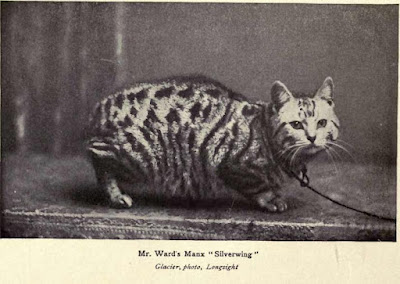Toch was in die tijd niet iedereen gecharmeerd van dit kattenras. Net een paar jaar voordat deze foto het licht zag, was dit stukje semi-wetenschappelijk proza gepubliceerd:
THE MANX CAT.
The Manx Cat differs from the ordinary cat only in being tailless, or nearly so, the most choice families not having any tail at all. If they have a short rudimentary tail it should be boneless; but sometimes they have short, thin, twisted tails, or tails in the shape of a knob. Some Manx Cats, however, have very long tails, even ten inches in length. The hind legs are proportionately longer and somewhat heavy, which gives the cat when running or jumping somewhat of the action of a rabbit; but this is more imaginary than real, and the supposed similarity is due rather to the character of the tail. Most Manx Cats are rather smallish, with a head small for their size, set on a thick and long neck. The eyes are large,
round, and full. The ears are medium-sized, rounded at the apex, and hairless within. The Manx Cat varies in color, running to Tabbies and all the mixed colors. A white Manx Cat is practically unknown, and black ones are excessively rare. The Manx Cat really can be classed as a monstrosity, having been developed probably by the interbreeding of some freak of nature in the form of a cat which inhabited the Island of Man at an early period. An ordinary cat can easily be rendered tailless if operated on at a young age; and as this is often done, especial attention should be paid to see that the absent tail is natural and that there is no scar as evidence of operative interference, or, as such things are called in dog shows, “faking.”
De tekst komt uit de uitgave The cat, a guide to the classification and varieties of cats and a short treatise upon their care, diseases, and treatment van Rush Shippen Huidekoper, M.D. (New York, D. Appleton and company, 1895). Extreem lange boektitels waren vroeger geen uitzondering, al was het maar om de diepgang van je onderzoek nog even in te wrijven. Je ziet het een enkele keer nog wel eens terug als grappig bedoeld anachronisme. Overigens zijn heruitgaven van dit boekje nog steeds te koop.
Niet om te jij-bakken, maar ik heb toch even een fotootje van dr. Huidekooper opgezocht (bron).Een Manx-cat mag dan een monstrosity zijn, als ik zou moeten kiezen tussen Silverwing en Huidekooper, zou ik wel weten welke foto ik aan de muur zou hangen. 


Geen opmerkingen:
Een reactie posten